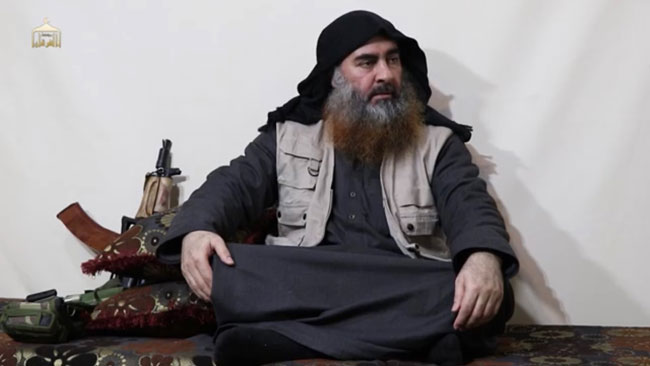The Easter Sunday terrorist attack in Sri Lanka was not in retaliation to a right-wing terrorist attacking two mosques in New Zealand, according to the elusive chief of the Islamic State group.
Sri Lanka’s government had previously claimed that the Easter Sunday bombings were retaliation for a recent attack on mosques in New Zealand.
State minister of defence Ruwan Wijewardene made the comment to politicians in parliament last week without providing evidence or explaining where the information came from about the attack.
The Islamic State (IS) released a new video on April 29, 2019 that the Easter Sunday attack in Sri Lanka was by the terror group.
In the video featuring the IS leader Abu Bakr al-Baghdadi, it is stated explicitly that the attacks in Sri Lanka was in retaliation for the loss of Baghuz, the last stronghold of Islamic State in Syria.
It is not clear when the video was recorded but the man appearing on the video who is believed to be the leader of the Islamic State group also said that the Sri Lanka attack was a “small part of the response prepared by the Islamic State”.
“The battle for Baghouz is over,” he said, sitting cross-legged on a cushion and addressing three men whose faces have been blurred.
“God ordered us to wage ‘jihad.’ He did not order us to win,” he said.
In a segment in which the man is not on camera, his voice referred to the April 21 Easter attacks in Sri Lanka, which killed 253 people and wounded nearly 500, as “vengeance for their brothers in Baghouz”.
The man said to be Baghdadi insisted IS’s operations against the West were part of a “long battle,” and that IS would continue to “take revenge” on members who had been killed.
“There will be more to come after this battle,” he said.
Professor Rohan Gunaratna, a counter-terrorism specialist, said that it is the first time Abu Bakr al Baghdadi has appeared in a video after five years. He added, “the success of the high profile attack in Sri Lanka made the IS leader highlight the attack.”
The shadowy leader of the Islamic State group appeared for the first time in five years in a video released by the extremist group’s propaganda arm on Monday, acknowledging defeat in the group’s last stronghold in Syria but vowing a “long battle” ahead.
The SITE Intelligence group said Abu Bakr al-Baghdadi, in the video, also discussed the Easter Day bombings in Sri Lanka that killed over 250 people and for which the group claimed responsibility.
The video released by Al-Furqan on Monday shows al-Baghdadi with a bushy grey and red beard, wearing a black robe with a beige vest and seated on the floor with what appears to be a machine gun propped up next to him. He is speaking with three men seated opposite him whose faces were covered and blotted out.
It is his first video appearance since he delivered a sermon at the al-Nuri mosque in the Iraqi city of Mosul in 2014. In that video, he appeared as a black-robed figure with a trimmed black beard to deliver a sermon from the pulpit of the mosque in which he urged Muslims around the world to swear allegiance to the caliphate and obey him as its leader.
Al-Bagdadi acknowledged that IS lost the war in the eastern Syrian village of Baghouz, which was captured last month by the US-backed Kurdish-led Syrian Democratic Forces.
“In fact, the battle of Islam and its people against the Crusaders and their followers is a long battle,” he said.
He said the battle of Baghouz showed the “barbarism and brutality” of the West and the “courage, steadfastness and resilience of the nation of Islam”.
“This steadfastness shocked the hearts of the Crusaders in what increased their rage,” he added.
Referring to the setbacks in battle, he said the “brothers” of the many fallen fighters “will avenge that, as they will not forget as long as they have blood in their veins, and there will be a battle after this one”.
It is unclear when or where the video was filmed. Al-Baghdadi spoke slowly and haltingly in the video.
With a US$25 million bounty on his head, al-Baghdadi is the world’s most wanted man, responsible for steering his chillingly violent organisation into mass slaughter of opponents, and directing and inspiring terror attacks across continents and in the heart of Europe.
Despite numerous claims about his death in the past few years, al-Baghdadi’s whereabouts remain a mystery. He appeared in public only once, in 2014. Since then, many of his top aides have been killed, mostly in US-led coalition air strikes.
He is among the few senior IS commanders still at large after two years of steady battlefield losses that saw the self-styled “caliphate” shrink from an area the size of Britain to a tiny speck in the Euphrates River valley.
Although largely seen as a symbolic figurehead of the global terror network – he was described as “irrelevant for a long time” by a coalition spokesman in 2017 – al-Baghdadi’s capture would be a coveted prize for the various players across both Syria and Iraq.
But so far, he has eluded the Americans, Russians, Syrians, Iraqis and Kurds.






